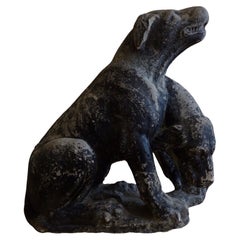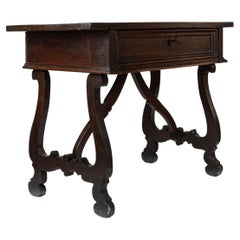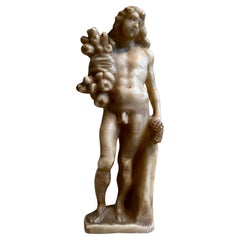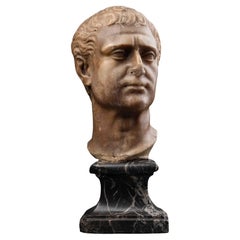Want more images or videos?
Request additional images or videos from the seller
1 of 5
Italian 17th Century Walnut and Leather Stool
Price:$3,278.29
$4,214.65List Price
About the Item
- Dimensions:Height: 16.15 in (41 cm)Width: 28.35 in (72 cm)Depth: 16.54 in (42 cm)
- Style:Louis XIII (Of the Period)
- Materials and Techniques:
- Place of Origin:
- Period:
- Date of Manufacture:17th Century
- Condition:Wear consistent with age and use. restoration to part of the leather (see pictures).
- Seller Location:Bruxelles, BE
- Reference Number:1stDibs: LU6666231645712
About the Seller
5.0
Vetted Professional Seller
Every seller passes strict standards for authenticity and reliability
1stDibs seller since 2022
15 sales on 1stDibs
Authenticity Guarantee
In the unlikely event there’s an issue with an item’s authenticity, contact us within 1 year for a full refund. DetailsMoney-Back Guarantee
If your item is not as described, is damaged in transit, or does not arrive, contact us within 7 days for a full refund. Details24-Hour Cancellation
You have a 24-hour grace period in which to reconsider your purchase, with no questions asked.Vetted Professional Sellers
Our world-class sellers must adhere to strict standards for service and quality, maintaining the integrity of our listings.Price-Match Guarantee
If you find that a seller listed the same item for a lower price elsewhere, we’ll match it.Trusted Global Delivery
Our best-in-class carrier network provides specialized shipping options worldwide, including custom delivery.You May Also Like
17th Century French Louis XIII Stool
Located in Chicago, IL
A gorgeous 17th century French Louis XIII walnut stool with barley twist legs and stretchers, and newly upholstered in a wool and linen bouclé. Perfect for tucking under a console table or nightstand, but also functions as a soft side table...
Category
Antique 17th Century French Louis XIII Stools
Materials
Bouclé, Walnut
LATE 17th CENTURY PAIR OF WALNUT STOOLS
Located in Firenze, FI
Elegant pair of stools in blond bride wood, finely set and twisted. The wood boasts a beautiful patina and their shape is characterized by a refined pattern of carving and turning. T...
Category
Antique Late 17th Century Italian Louis XIV Stools
Materials
Velvet, Walnut
Pair of 17th century Rustic Walnut Stools
Located in Troy, NY
Charming pair of small stools, bobbin turned legs, joined by box stretchers, octagonal tops, beautiful worn and dried out look.
Category
Antique 17th Century French Baroque Stools
Materials
Walnut
17th Century oak joined stool
Located in Bakewell, GB
17th Century oak joined stool in excellent condition and colour
Circa 1680
57cms high 44cms wide 30cms deep
Category
Antique 1680s Stools
Materials
Oak
Oak Upholstered Stool 17th Century
Located in Bakewell, GB
C1680 oak upholstered stool with turned legs and square section stretchers top upholstered with kilim rug
52 cms high 40 long 34 deep price
Category
Antique 17th Century English Stools
Materials
Oak
17th Century Style Joint Stool
Located in Westwood, NJ
An antiqued wood ‘Joynt’ stool, with a serpentine apron on pegged splay legs joined by a stretcher. The original 17th century.
Dimensions: 22" W x 12" D x 18" H.
Category
21st Century and Contemporary Vietnamese Jacobean Benches
Materials
Wood
17th Century oak joined stool
Located in Bakewell, GB
17th Century oak joined stool of good colour and patination and original condition well turned legs size top 49cms x 27 and 49 high.
Category
Antique 17th Century English Country Stools
Materials
Oak
17th Century English Oak Joint Stool
Located in San Francisco, CA
17th century English joint stool with turned legs and decorated apron.
Works as a stool or low side table next to a chair.
In very good antique condition with expected signs of use a...
Category
Antique 17th Century English Stools
Materials
Oak
PAIR OF 17th CENTURY FALDSTOOLS STOOLS
Located in Firenze, FI
Elegant pair of faldstools in solid hand-carved walnut. The stools are distinguished by their ace-of-cups-shaped legs, joined by linear crosspieces. The design is completed by real f...
Category
Antique 17th Century Italian Louis XIV Stools
Materials
Fur, Walnut
English 17th Century Jacobean Style Stool
Located in Baton Rouge, LA
An English Jacobean style solid oak stool or side table made in the late 1600’s is held together with peg joinery. The rectangular single plank top rests over a hand carved and scall...
Category
Antique 17th Century English Jacobean Stools
Materials
Oak
More From This Seller
View AllCerberus, Italy, 17th Century
Located in Bruxelles, BE
Cerberus
Black painted stone
Italy, 17th century
Measures: 80 x 69 x 36cm
(one head missing)
Cerberus, cruel monster, fierce and strange,
Through his wide threefold throat barks as a dog
Over the multitude immers'd beneath.
His eyes glare crimson, black his unctuous beard,
His belly large, and claw'd the hands, with which
He tears the spirits, flays them, and their limbs
Piecemeal disparts (Dante, Inferno, Canto VI).
Cerberus figure seated, in his role of ferocious guardian of the underworld; he shows a nervous musculature, an adherent skin which reveals the ribs, long and robust limbs; his heads are broad and the eyes set well apart.
Painted in black to amplify his menacing look, the infernal guardian is depicted with his famous attributes, writhing his heads, growling and barking furiously.
Cerberus, in Greek mythology, was the monstrous watchdog of the underworld – also known as the “hound of Hades” – preventing the dead from leaving, and making sure that those who entered never left.
A child of Typhon and Echidna, he was part of a monstrous family, which included Orthus, the Lernaean Hydra, and the Chimaera as well. Only on three occasions Cerberus was tricked by visitors of Hades: Heracles did it with his strength, Orpheus with his music.
In "The Inferno", Dante places Cerberus as the guardian of the third circle of Hell. With his three mouths, Dante saw Cerberus as a beast that was synonymous with the sin of Gluttony. Virgil gets past the monster by throwing mud in his three mouths, temporarily choking him.
Very rare are the representations of Cerberus in ancient statuary...
Category
Antique 17th Century Italian Renaissance Figurative Sculptures
Materials
Stone
$19,869 Sale Price
25% Off
Walnut Table "a lira" - Tuscany, 17th century
Located in Bruxelles, BE
Walnut Table "a lira" - Tuscany, XVII century
Table “a lira”
Walnut
Tuscany, XVIIth century
71 X 90 X 49,5 cm
Beautiful patina.
Category
Antique 17th Century Italian Renaissance Desks and Writing Tables
Materials
Walnut
Bacchus - Southern Italy, late 17th century
Located in Bruxelles, BE
Bacchus
Southern Italy, late 17th century
Alabaster Sculpture
H: 20 cm
A finely carved 17th-century alabaster sculpture of a naked Bacchus. This Italian alabaster figure depicts ...
Category
Antique 17th Century Italian Baroque Figurative Sculptures
Materials
Alabaster
Renaissance Marble Portrait - Northern Italy, 17th century
Located in Bruxelles, BE
Renaissance Marble Portrait
Northern Italy, 17th century, inspired by antiquity
Marble
36 x 13 cm (including the marble pedestal)
This Renaissance portrait head of a young man, sl...
Category
Antique 17th Century Italian Renaissance Figurative Sculptures
Materials
Marble
$9,633 Sale Price
20% Off
Boiled Leather Trunk, Spanish, 17th Century
Located in Bruxelles, BE
Leather trunk
Spanish, 17th century
Boiled Leather, wood and iron
Measures: 22 x 53 x 32 cm.
Provenance :
- collection Metz-Noblat, Château de Clevant, France
Rectangular trunk of the form and size of a small suitcase with wrought iron hinges and lock-plate.
Wood, covered with leather, cut and embossed with every surface of the thick cow hide covered in interlace, zoomorphic features.
The construction method is boiled leather, often referred to by its French translation cuir-bouilli: a process used to change flexible, vegetable-tanned leather into rigid, moulded objects. For shaping of the vegetable-tanned leather, heat and moisture were used, as indicated by the term boiled leather. No written medieval sources describing the production of decorated cuir bouilli objects survive, so knowledge of the process relies on the important studies of the Scottish leather historian John William Waterer. A large range of methods, materials and techniques could be used in various combinations. The vegetable-tanned leather, made supple with moisture and heat, was stuffed, shaped and nailed to the rigid wooden coffer support. The stuffing material was probably modeled beeswax or stearin wax. To shape the leather, to create its topography, « Cushions » were made by lacing a thread through an awl hole and attaching the flexible leather and stuffing to the rigid wooden support on the bottom. Then the decoration was done: lines were incised through the upper layer of the leather (epidermis) with different thicknesses of knives or needles. Contours were created with deep v-shaped cuts, decoration with thin incision and final details with a needle point. For the incision and pouncing stage, the leather was probably kept heated and moistened for suppleness.
Once dry, the leather would be hard and rigid.
the saturated leather is worked over a form, possibly even damp sand, with the pattern shaped using bone or wooden tools. Compare to metal, leather was lighter and it offered protection from cuts and punctures. Cuir bouilli objects were produced by specialist leather workers and needed skillful craftsmanship.
The surface is filled with roundels shaped foliages enclosing animals, lions and peacocks. The foliate arabesques creating a vegetal connection tweet the animals create the impression of a lush verdant space . The vegetal pattern here employed in combination with geometrical pattern came from the pre-islamic artistic traditions of the Byzantine and Sasanian empires. An aspect of Islamic geometry Is the basic symmetrical repetition and mirroring of the shapes that create a sense of harmony.
The decoration of this truck is inspired by the islamic « arabesque » a form of vegetal ornament composed of spirals, intertwining plants and abstract curvilinear motifs. An arabesque character is given to the birds of the decorations through extreme stylisation. This arabesque maintained the classical tradition of median symmetry, freedom in Detail and heterogeneity of ornament.
The presence of the peacocks is a paradisiacal allusion: in popular Islamic literature they were among the original inhabitants of the garden of Paradise expelled with Adam and Eve. Peacock as a decorative motif may have originated in the West, despite their eastern provenance. There was an ancient belief that the flesh and feathers of peacock do not decay. This led to the peacock becoming a christian symbol for Christ’s resurrection.
Renowned for their decorative wall hangings, seventeenth-century Spanish leatherworkers also produced utilitarian objects, such as this trunk. A similar trunk is on display at the Metropolitan museum of art ( 09.158.1).
Related literature :
Davies L. 2006. Cuir bouilli. Conservation of leather and related materials, 94-102, Oxford: elsevier Butterworth-Heinemann
Grabar, Oleg. The Mediation of Ornament. Princeton: Princeton University Press, 1992
Gabriela Germana Roquez, "El mueble en el Peru en el siglo XVIII...
Category
Antique 17th Century Decorative Boxes
Materials
Iron
17th century twisted column
Located in Bruxelles, BE
Twisted Column
Italy, 17th Century
H 22 cm x diameter 21,5 cm
central hole diameter : 9,2 cm
This sculpted stone, dating from the 17th century, is a fragment of a twisted or helical...
Category
Antique 17th Century Italian Renaissance Planters and Jardinieres
Materials
Stone
Recently Viewed
View AllMore Ways To Browse
Turquoise Garden Stool
Artemide Efebino
Chesterfield Piano Stool
Chinese Small Stool
Ficks Reed Bar Stools
Harry Bertoia Wire Stools
Herman Miller Barstool
Kaare Klint Propeller
Karim Rashid Kant
Marria Pratts
Pair Barstool Brass Swivel
Stool Hole
Antique Piano Leg
Cherner Counter Stools
Chippendale Bar Stools
Dressing Room Ottoman
Indian Brass Stool
Lions Of Frost Stools



